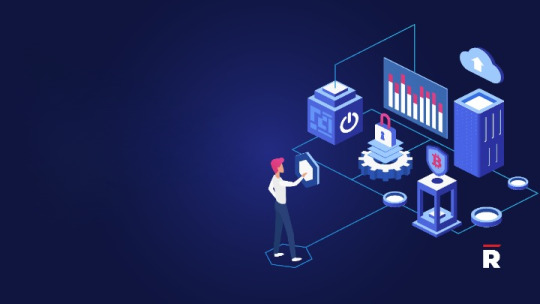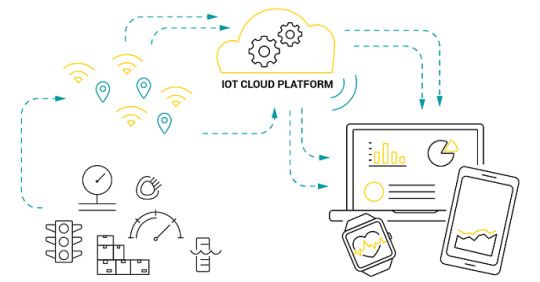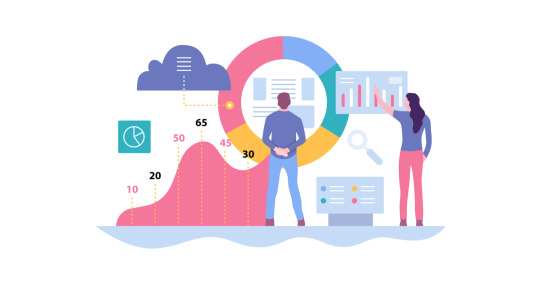#IoTAnalytics
Explore tagged Tumblr posts
Text
Bridging IoT and Data Intelligence
💡 Modern IoT software doesn’t just collect data—it transforms it into intelligence. The key? A data architecture that enables real-time processing, cloud integration, and AI analytics.
Bridgera’s approach empowers businesses to unlock true value from their connected assets.
📈 Read how data flows power smarter IoT solutions: https://bridgera.com/a-comprehensive-guide-to-iot-software-development-process/
0 notes
Text
🚀𝐇𝐨𝐰 𝐈𝐨𝐓 𝐒𝐞𝐧𝐬𝐨𝐫𝐬 𝐀𝐫𝐞 𝐑𝐞𝐯𝐨𝐥𝐮𝐭𝐢𝐨𝐧𝐢𝐳𝐢𝐧𝐠 𝐈𝐧𝐝𝐮𝐬𝐭𝐫𝐢𝐞𝐬 𝐢𝐧 𝟐𝟎𝟐𝟓 | IndustryARC™
The global IoT sensors market size was estimated at USD 13.36 billion in 2023 and is expected to grow at a CAGR of 36.8% from 2024 to 2030.
👉𝑫𝒐𝒘𝒏𝒍𝒐𝒂𝒅 𝑺𝒂𝒎𝒑𝒍𝒆 𝑹𝒆𝒑𝒐𝒓𝒕
The #IoT #Sensors Market refers to the industry focused on sensors that are used in Internet of Things (#IoT) applications. These sensors collect and transmit data, enabling smart devices, industrial automation, and real-time monitoring across various sectors.
🔹𝐈𝐧𝐜𝐫𝐞𝐚𝐬𝐞𝐝 𝐔𝐬𝐞 𝐨𝐟 𝐀𝐈 𝐚𝐧𝐝 𝐌𝐚𝐜𝐡𝐢𝐧𝐞 𝐋𝐞𝐚𝐫𝐧𝐢𝐧𝐠:
Edge Computing combined with #AI and #machine_learning will help process sensor #data faster and more efficiently, reducing latency and bandwidth usage. Sensors will become smarter, capable of performing complex analytics at the edge, enabling real-time decision-making without the need for a central cloud server.
Request PDF Sample Copy of Report: (Including Full TOC, List of Tables & Figures, Chart)
🔹𝐌𝐢𝐧𝐢𝐚𝐭𝐮𝐫𝐢𝐳𝐚𝐭𝐢𝐨𝐧 𝐨𝐟 𝐒𝐞𝐧𝐬𝐨𝐫𝐬:
As IoT applications require more compact, energy-efficient devices, we can expect sensors to become increasingly smaller while maintaining or enhancing their performance. Miniaturized sensors will enable integration into a wide variety of devices, especially in wearables, healthcare, and smart consumer products.
𝐒𝐦𝐚𝐫𝐭 𝐒𝐞𝐧𝐬𝐨𝐫𝐬 𝐰𝐢𝐭𝐡 𝐌𝐮𝐥𝐭𝐢-𝐟𝐮𝐧𝐜𝐭𝐢𝐨𝐧𝐚𝐥𝐢𝐭𝐲:
The trend toward multi-sensor devices that combine various sensing capabilities in one chip (e.g., temperature, humidity, and pressure sensing in a single sensor) will continue to grow.
Get this Report on discount of $1000 on purchase of Credit Card
𝐓𝐲𝐩𝐞𝐬 𝐨𝐟 𝐈𝐨𝐓 𝐒𝐞𝐧𝐬𝐨𝐫𝐬:
🔹Temperature Sensors (e.g., HVAC, smart thermostats)
🔹Pressure Sensors (e.g., industrial automation, smart grids)
🔹Proximity Sensors (e.g., automotive, retail)
🔹Motion & Occupancy Sensors (e.g., security systems, smart homes)
🔹Gas Sensors (e.g., air quality monitoring, smart agriculture)
🔹Image & Optical Sensors (e.g., smart cameras, biometric systems)
🔹Humidity Sensors (e.g., weather forecasting, industrial control)
➡️ 𝐤𝐞𝐲 𝐏𝐥𝐚𝐲𝐞𝐫𝐬 : NXP Semiconductors | Bosch Global Software Technologies | Honeywell Industrial Automation | Amkor Technology, Inc. | KYOCERA AVX Components Corporation | Parker Electromechanical and Drive Technology | C&K | BOE Technology Group Co., Ltd. | Spark Minda | Salcomp Plc | TDK Americas | ALPS ALPINE Europe | Panoramic Power | TESEO S.p.A — Eiffage Energy Systems Italy | Advantech Malaysia |
#IoTSensors#SmartSensors#IIoT#IndustrialIoT#EdgeComputing#AIoT#IoTDevices#SensorTechnology#IoTAnalytics#5GIoT#WirelessSensors#ConnectedDevices#Automation#Industry40#DigitalTransformation#EmbeddedSensors#SmartManufacturing#DataDriven#CloudIoT#IoTInnovation
0 notes
Text
Challenges and Use Cases of IoT Analytics Explained

In our interconnected world, the internet has become integral to our daily lives, driving vast data consumption and production. In 2023, there were 30.73 billion IoT devices, contributing to the Internet of Things (IoT) ecosystem where people, technologies, networks, and tools collaborate to achieve common goals. IoT spending reached a staggering $1.1 trillion USD in 2023.
IoT Analytics Explained
IoT analytics is the process of collecting, processing, and analyzing data generated by IoT devices. This involves transforming raw data into meaningful insights and actionable knowledge. With an increasing number of connected devices, access to valuable information is expanding rapidly, with projections indicating over 25.40 billion IoT-connected devices in the next six years.
Key Components of IoT Analytics
Data Collection: IoT devices are equipped with sensors that gather various data, such as temperature, humidity, pressure, and motion, which is then sent to a central server or cloud platform.
Data Storage: The vast amount of data generated requires robust storage systems capable of handling its volume, speed, and variety.
Data Processing: Collected data must be cleaned, transformed, and organized for analysis to extract valuable insights.
Data Analysis: Various techniques and tools are employed to uncover patterns, trends, and connections within the processed data.
Visualization and Reporting: Insights are presented visually through charts, graphs, and dashboards, making them easier to understand and interpret.
Organizations can leverage IoT analytics to gain insights, improve operations, and make informed decisions across diverse fields, including manufacturing and healthcare.
Applications of IoT Analytics
Predictive Maintenance: IoT analytics enables the monitoring of equipment conditions and prediction of maintenance needs, reducing downtime and improving planning.
Industrial Optimization: Industries like manufacturing, transportation, and utilities can enhance efficiency, product quality, and customer service by analyzing IoT data.
Smart Agriculture: By analyzing data from sensors and weather stations, farmers can optimize irrigation, predict crop yields, and make informed decisions to boost productivity and minimize waste.
Healthcare: IoT is transforming healthcare with remote patient monitoring, real-time health tracking, and personalized care. Analyzing data from wearable devices and medical sensors provides valuable insights for improving diagnostics and treatment outcomes.
Smart Cities: IoT analytics is crucial for building smart cities by optimizing transportation, managing resources efficiently, and enhancing urban planning through data analysis from traffic, environmental, and energy sensors.
Supply Chain Optimization: By tracking inventory, monitoring logistics, and predicting demand, IoT data can streamline processes, reduce costs, and improve customer satisfaction.
Challenges of IoT Analytics
Data Management: Managing the massive and diverse data generated by IoT devices is complex and resource-intensive, requiring careful handling of various data formats.
Storage and Scaling: Traditional storage systems may struggle with the scale and speed of IoT data, necessitating robust and scalable solutions.
Real-Time Processing: Timely decision-making demands real-time or near-real-time processing of data streams, emphasizing low latency and high throughput.
Security and Privacy: Protecting sensitive IoT data from unauthorized access and adhering to privacy regulations is critical, requiring robust encryption and compliance measures.
Interoperability and Integration: Integrating IoT devices and systems from different vendors using various protocols and standards is challenging, demanding seamless data integration.
Future Outlook
The future of IoT analytics is promising, with potential advancements in predictive maintenance, optimized operations, personalized healthcare, and efficient resource management. As connectivity and data generation continue to grow, organizations must address challenges like data security, scalability, and interoperability. By effectively collecting, processing, and analyzing IoT data, businesses can drive innovation, enhance efficiency, and unlock new levels of productivity and connectivity in our evolving world.
0 notes
Text

#IoTAnalytics#InternetOfThings#DataAnalytics#BigData#PredictiveMaintenance#RealTimeAnalytics#AIinAnalytics#IoTDevices#SmartCities#DataSecurity#EdgeAnalytics#DigitalTransformation#Industry40#MachineLearning#DataVisualization
0 notes
Text
Role of IoT Cloud Platforms in Shaping Industries: Data-driven Future
The global IoT cloud platform market size is anticipated to reach USD 51.3 billion by 2030, according to a new report by Grand View Research, Inc. The market is expected to expand at a CAGR of 14.6% from 2023 to 2030. The rapid adoption of internet of things (IoT) cloud platforms to connect hardware, such as sensors and smart devices to the cloud, to handle different communication protocols, and provide reliability, security, and authentication for users and devices is driving the IoT cloud platform market growth. In addition, the growing use of AI and ML integrated IoT platforms among organizations to reduce costs and maintain a competitive advantage is expected to boost the IoT cloud platform market growth.

IoT Cloud Platform Market Report Highlights
By offering, the platform segment accounted for the major revenue share of 68.3% in 2022 and is anticipated to maintain its dominance over the forecast period. Increased adoption of IoT cloud platform as it helps to minimize risk and reduce development & operational costs are driving the segment growth. It also offers capabilities to help and analyze organizations to achieve business-critical needs with increased agility
The service segment is expected to witness the fastest growth rate of 15.5% during the forecast period. Growing demand for IoT cloud services such as training, consulting, integration, deployment, support, and maintenance services are boosting the segment’s growth
Commercial deployment segment held the largest market share of 47.3% in 2022 and is expected to retain its position over the forecast period. Increasing use of commercial cloud deployment model owing to its benefits such as high flexibility and scalability, easy deployment, and minimal maintenance costs is boosting the segment growth
Hybrid deployment segment is expected to grow at the fastest CAGR of 15.5% during the forecast period owing to its low cost and greater security and control over critical workloads
In terms of organization size, large-size organizations segment dominated the market and captured the largest revenue share of 67.3% in 2022. The increasing use of IoT cloud platforms by large enterprises from manufacturing, retail, smart city, transportation, and healthcare verticals to optimize and monitor their IoT business processes is attributed to segment growth
The small and medium sized organizations segment is expected to witness the fastest growth rate of 15.3% during the forecast period. Growing investments in the adoption of new and advanced technologies and the rising shifts towards cloud-based services are propelling segment growth
In terms of the application, the industrial automation & smart manufacturing segment accounted for the major revenue share of 21.5% in 2022 and is anticipated to maintain its dominance over the estimated timeframe. Factors such as the increasing involvement of the government in supporting smart manufacturing and the adoption of cloud technologies are driving the segment growth
The healthcare segment is expected to grow at a CAGR of 15.9% during the forecast period. With the growing use of smart devices, Artificial Intelligence (AI), and cloud technologies, the demand for IoT cloud platforms is expected to increase in the healthcare industry
North America held the largest market share of 32.0% in 2022 and is expected to retain its position over the forecast period. An increase in IoT spending across the U.S. and Canada, early adoption of IoT platforms across the industrial segment, and the presence of leading market players such as Microsoft (U.S.), AWS (U.S.), and Google (U.S.) are driving the IoT cloud platform market growth in this region
Asia Pacific is expected to grow at the fastest CAGR of 15.8% during the forecast period owing to the rise in investments in smart manufacturing, smart cities, and the connected vehicle sector.
For More Details or Sample Copy please visit link @: IoT Cloud Platform Market Report
A rise in the demand for IoT cloud platforms from the healthcare sector is driving the market growth. The growing use of IoT cloud platforms and services during the COVID-19 pandemic period owing to their ability to transform a complete healthcare delivery system is fueling the growth of the IoT cloud platform market. Telemedicine, robotic sanitization, contact tracing, and data protection and privacy are some of the important services provided by IoT in the healthcare sector. In addition, the adoption of IoT cloud in database design to integrate the cloud and the smart hospital information system is also expected to boost market growth.
#IoTCloud#CloudPlatform#InternetofThings#IoTMarket#ConnectedDevices#IoTInfrastructure#CloudComputing#EdgeComputing#IoTSolutions#IoTEcosystem#SmartDevices#IoTIntegration#CloudSecurity#IoTAnalytics#Industry40#IoTApplications#IoTInnovation#TechMarketTrends
0 notes
Link
#5g#analytics#business#businessesgrowth#cloudsystem#growthofbusinesses#internet#IOT#IOTanalytics#technology#vitalsystems
0 notes
Text
Discover how the basics of loT predictive maintenance can improve the value of your business. To know more about browse: https://teksun.com/ Contact us ID: [email protected]
#IoT predictive maintenance solutions#predictive maintenance#AI solutions#IoTTechnology#IoTAnalytics
1 note
·
View note
Text
IoT-based healthcare systems make remote monitoring of patients a reality. We deliver IoT healthcare solutions that will undoubtedly transform the way you run your hospitals.
Give us a call now to learn about harnessing digital power in your healthcare operations. WhatsApp: https://wa.me/919535555225
#IoT#InternetOfThings#SmartDevices#ConnectedWorld#IoTInnovation#SmartCities#IoTSolutions#IoTTechnology#IndustrialIoT#IoTSecurity#SmartHomes#IoTAnalytics#IoTData#SmartGrid#IoTApplications#IoTPlatform#IoTIndustry#IoTDevices#IoTConnectivity#IoTDevelopment#june#softwarecompany#digital#healthcare#power#hospitals
0 notes
Text
"Data That Delivers: BDaaS Market Growth 2025–2033 📊☁️"
BDaaS Market is reshaping the way businesses process and analyze vast datasets by offering cloud-based solutions. It encompasses data storage, management, and analytics services that eliminate the need for extensive infrastructure, enabling scalable and cost-effective access to advanced data tools. This fosters data-driven decision-making and innovation across diverse industries.
To Request Sample Report: https://www.globalinsightservices.com/request-sample/?id=GIS32185 &utm_source=SnehaPatil&utm_medium=Article
The BDaaS market is expanding rapidly, primarily fueled by the widespread adoption of cloud services. The IT and telecom sector leads the market, leveraging BDaaS to manage large-scale data operations. The BFSI (Banking, Financial Services, and Insurance) sector follows, driven by the growing need for data-driven customer experiences and operational efficiency.
Regionally, North America dominates the BDaaS market due to its advanced IT infrastructure and the presence of major technology players. Europe ranks second, with growing emphasis on digital transformation and stringent regulatory compliance. The United States leads globally, backed by its innovation-driven economy, while Germany shows significant potential with increasing investments in digital technologies.
In 2023, the market reached an estimated volume of 350 million terabytes. Public cloud solutions hold the largest market share at 45%, followed by hybrid cloud at 30% and private cloud at 25%. Key players like IBM, Microsoft Azure, and Amazon Web Services are shaping the competitive landscape with innovative offerings such as AI-integrated analytics and real-time data processing.
While the market faces challenges like data privacy concerns and high implementation costs, it is projected to grow at an annual rate of 15%, driven by rising data generation and the demand for analytics-driven insights. Emerging opportunities in AI-driven analytics and IoT integration promise to redefine the BDaaS landscape, unlocking immense potential for businesses
#BigDataAsAService #BDaaSMarket #CloudComputing #DataAnalytics #DataDrivenDecisions #TechInnovation #DigitalTransformation #AIInData #IoTAnalytics #RealTimeData #ScalableSolutions #BFSIInnovation #PublicCloud #HybridCloud #FutureOfData
0 notes
Text
Turning IoT Data into a Competitive Advantage
The real strength of IoT isn't connectivity—it's data-driven insight. Most OEMs struggle with collecting, storing, and analyzing real-time data and miss out on valuable insights. With deeper IoT analytics, businesses can forecast failures, maximize performance, and tap into new revenue. With Bridgera's IoT offerings, OEMs can leverage real-time data for intelligent product development and operation efficiency. Don't waste data—use it as your greatest asset.
0 notes
Text
IoT Analytics to exhibit staggering Growth in upcoming years
Today, the Internet of Things (IoT) is becoming increasingly popular. As the number of devices connected to the internet continues to grow, so does the need for effective IoT analytics.
IoT analytics can help users understand how their devices are performing and how they can improve their operations. By understanding where problems are and how to fix them, users can enhance their overall IoT experience.
There are a number of different IoT analytics applications that can be used to help users optimize their operations. Some of the most popular applications include:
IoT device management
Connected vehicles
Traffic management
Smart grids
Environmental monitoring
Smart buildings and smart homes
Smart cities
Supply chain management
Industrial, agricultural and commercial management
To Explore more Articles Click Here

1 note
·
View note
Text
¿Cómo avanza el desarrollo de IoT Analytics tras la digitalización en pandemia?
¿Cómo avanza el desarrollo de IoT Analytics tras la digitalización en pandemia?
La digitalización se ha desarrollado de forma exponencial desde la llegada de la pandemia, lo que ha generado que actualmente muchos negocios vean la utilización de tecnología como algo fundamental para su desarrollo e incluso les cuesta imaginar un modelo sin estas herramientas, impulsando el IoT Analytics. Pero sin duda una tendencia que destaca es el crecimiento de soluciones de IoT Analytics,…

View On WordPress
0 notes
Text
IoT Dashboard: An Upgrade to Remote Monitorin

When it comes to enterprise level technology, technicians require a great degree of specialization. In contrast, the people using this equipment usually do not understand how it works. A perfect example of this is the common car. Most people do not understand the inner workings of their car. Even mechanics these days usually specialize on a specific make, due to proprietary tools or software. However, these individuals can get behind the wheel of almost any car, and drive it with ease.
This is made possible by an intuitive dashboard that provides data relevant to the driving experience. As it relates to industrial IoT Dashboards, this technology allows workers the ability to operate manufacturing equipment efficiently without a degree in mechanical engineering.
Turning back to the car dashboard analogy, if an individual desires more driving insights, then newer cars can provide this. However, it is rarely practical to replace manufacturing equipment in this way. Instead, a company like Bridgera can customize an IoT dashboard that is compatible with existing equipment. Think of it as an aftermarket upgrade that provides new features without upgrading the whole vehicle. Learn more about how Bridgera specializes in creating IoT Dashboards for your industry sector!
Read Blog: IoT Dashboard: An Upgrade to Remote Monitoring
#realme c17 iot products india support page launch indication smart bulb power bank watch realme#iot#iotdashboard#iotanalytics
0 notes